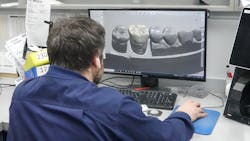How to choose the right CAD/CAM design software
The longer I work in dentistry and meet clinical experts, the more amazed I am at the simplicity of digital dentistry, aka CAD/CAM dentistry, when it’s broken down into its basic parts. I used to understand when long-time dentists said they didn’t want to adapt to the technology, but I can no longer support that concept. It’s simply too easy now. If you can use a smartphone, you can adopt digital dentistry
Hopefully, you’re aware that scanning is the easiest part of the CAD/CAM design process. Any dentist who is not taking advantage of the basic benefits of a digital workflow is simply working harder instead of smarter. Cheaper production, faster turnaround, and exponential precision are just a few of the benefits. Once you see how easy and affordable it is to incorporate basic intraoral scanning, you’ll kick yourself for waiting so long.
Digital scanning is the bare minimum of what you should be doing. Designing, on the other hand—just suffice it to say the premise can be overwhelming. One of the hurdles with design software has always been that it was created with lab experts in mind, the theory being that technical staff would be doing more designing than clinicians. It’s no wonder that many dentists send scans to labs to be designed “by the experts.” Coincidence? Who knows?
This trend is slowly changing. With the boom in digital and CAD/CAM dentistry, many doctors are making the leap to bring some or all of that workflow in-house to be done chairside. The good news is innovation is making it easier. Some manufacturers are making software geared more for dental teams. You must know what to look for and receive enough feedback to corroborate your choices.
Ease of use in design software is not nearly as prevalent as it should be. One way to learn whether you’re looking at a simplified version of a lab-friendly program is by how many clicks it takes to design a restoration. Some design software can be very intimidating, not to mention expensive, even for those who have already dabbled in the craft. Several are simply toned-down versions of overly technical lab software, but they still carry a myriad of unnecessary options. By the time you get through the downloads and configurations with some platforms, your patience is exhausted.
What else should you consider?
There is convenience and ease of use that comes with a closed, all-inclusive system, but buying design software embedded into a complete system comes at a price. Full systems come with their own design software and are easy to use because of their seamless operation with their other components. But the sum of the parts might send you into the highest end of the price range for all do-it-yourself CAD/CAM systems. Furthermore, if you’re not ready to prep and mill restorations, you’ll still be tethered to the brand by purchasing software that is built into a full (and closed) system.
Going with design software that stands on its own allows you the freedom to try other brands. If you can purchase a basic scanner for half the price, wouldn’t you rather have two moving around your office than one, tied to your full system? Besides the fees of the equipment, there are some that carry a price tag in the thousands for the software, licensing, and yearly subscription fees. There are not many platforms that allow users to get by on a manageable fee or operate without storage space, but there are one or two that are cloud-based, with no storage needed.
What can you do to educate yourself? First, if you know a trustworthy digital dentistry sales rep, ask them questions. It would be beneficial to find someone who has sold more than one or two brands. Chances are they’ve had experiences with each product and can share the highs and lows for the brands you’re considering. Second, seek out your peers, in person and on social media. There are many dentistry groups where members share positive and negative experiences, discuss cases for feedback, and offer advice on a variety of topics.
The bottom line? Design software exists in many forms. Locating the diamond in the rough for your practice requires due diligence. The best of the best will be noticeably convenient, innovative, easier to use, and designed by those who have seen it all. Fees are all over the place, so find out exactly what you’ll be paying for, both initially and after the transaction is complete. There is a right product for everyone, including you.
About the Author

Matthew Newman
Matthew Newman is the operations manager for the Baltimore/District of Columbia/Northern Virginia region of Patterson Dental. With 20 years of experience in operational management, he has spent the bulk of his time in both business-to-business/distribution and hospitality. He can be reached via messenger on LinkedIn (linkedin.com/in/matthew-newman-9582979/).
